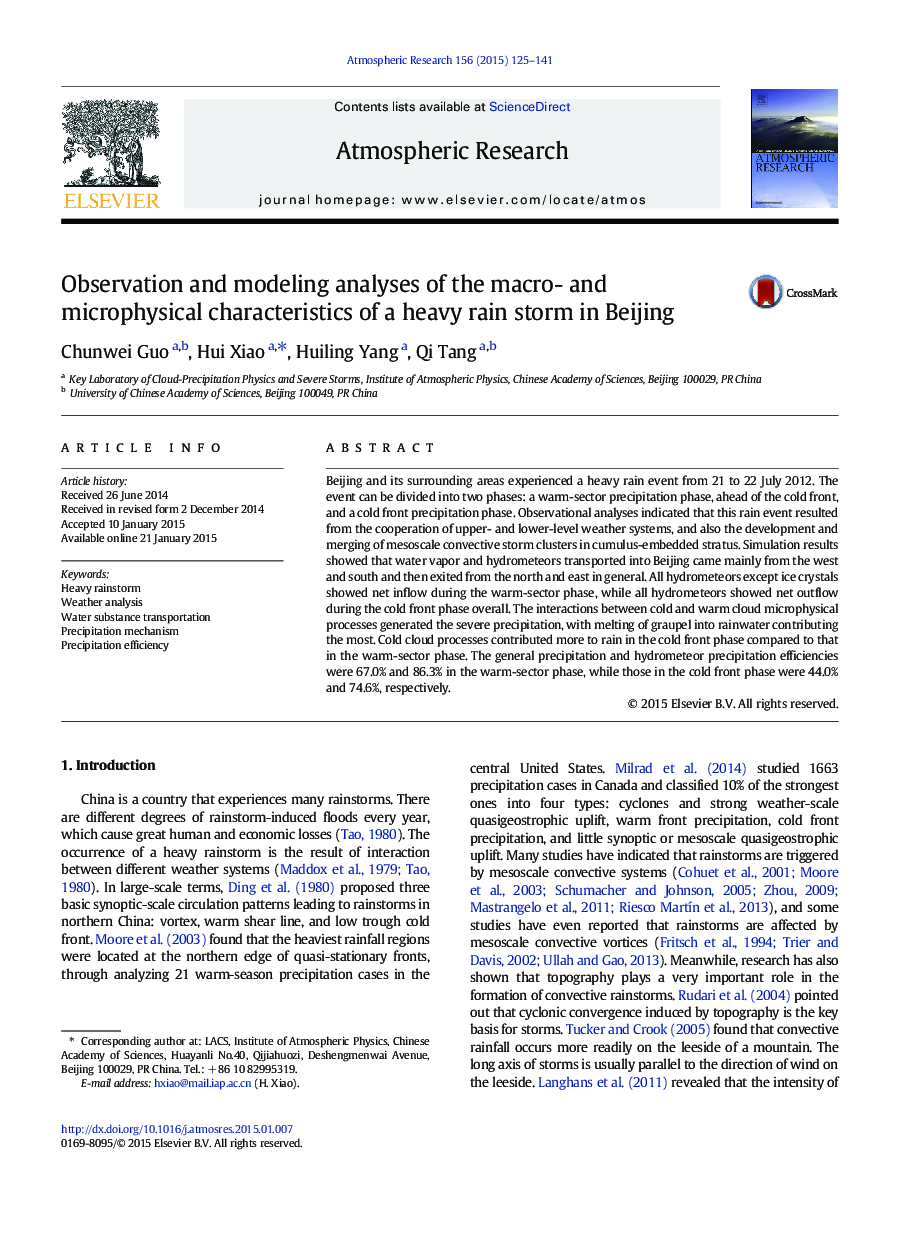| کد مقاله | کد نشریه | سال انتشار | مقاله انگلیسی | نسخه تمام متن |
|---|---|---|---|---|
| 6343349 | 1620517 | 2015 | 17 صفحه PDF | دانلود رایگان |
عنوان انگلیسی مقاله ISI
Observation and modeling analyses of the macro- and microphysical characteristics of a heavy rain storm in Beijing
ترجمه فارسی عنوان
بررسی و مدل سازی تجزیه و تحلیل ویژگی های کلان و میکرو فیزیکی یک طوفان باران سنگین در پکن
دانلود مقاله + سفارش ترجمه
دانلود مقاله ISI انگلیسی
رایگان برای ایرانیان
کلمات کلیدی
باران سنگین تجزیه و تحلیل آب و هوا، حمل و نقل ماده آب، مکانیزم بارش، راندمان بارش،
ترجمه چکیده
پکن و مناطق اطراف آن یک رویداد بارانی شدید از 21 تا 22 ژوئیه 2012 را تجربه کردند. این رویداد را می توان به دو مرحله تقسیم کرد: مرحله بارش باران گرم، پیش از جلوی سرد و یک مرحله بارش یخبندان. تجزیه و تحلیل مشاهدات نشان داد که این رخداد باران ناشی از همکاری سیستم های آب و هوایی سطح بالا و پایین و همچنین توسعه و ادغام خوشه های طوفان مادون ماهواره ای در شیفت های کومولیوس جاسازی شده است. نتایج شبیه سازی نشان داد که بخار آب و هیدرومتورها به پکن منتقل می شود عمدتا از غرب و جنوب و سپس به طور کلی از شمال و شرق خارج می شود. تمام هیدروموتورها به جز یخ کریستال، جریان خالص را در طول مرحله ی بخش گرم نشان دادند، در حالیکه تمام هیدروموتورها در جریان فاز سرد به طور کلی، خروجی خالص داشتند. تعاملات بین فرآیندهای میکرو فیزیکی ابر و سرما باعث بارندگی شدیدی شد، با ذوب شدن دانه گرده به آب باران که بیشترین تأثیر را داشته است. فرایندهای ابر سرد باعث افزایش بارندگی در فاز سرد جلوتر شده است. بارش باران و بارش هیدروتئوری بارندگی 67.0٪ و 3/86٪ در فاز گرم بود، در حالی که آن ها در فاز سرد به ترتیب 44.0٪ و 74.6٪ بود.
موضوعات مرتبط
مهندسی و علوم پایه
علوم زمین و سیارات
علم هواشناسی
چکیده انگلیسی
Beijing and its surrounding areas experienced a heavy rain event from 21 to 22 July 2012. The event can be divided into two phases: a warm-sector precipitation phase, ahead of the cold front, and a cold front precipitation phase. Observational analyses indicated that this rain event resulted from the cooperation of upper- and lower-level weather systems, and also the development and merging of mesoscale convective storm clusters in cumulus-embedded stratus. Simulation results showed that water vapor and hydrometeors transported into Beijing came mainly from the west and south and then exited from the north and east in general. All hydrometeors except ice crystals showed net inflow during the warm-sector phase, while all hydrometeors showed net outflow during the cold front phase overall. The interactions between cold and warm cloud microphysical processes generated the severe precipitation, with melting of graupel into rainwater contributing the most. Cold cloud processes contributed more to rain in the cold front phase compared to that in the warm-sector phase. The general precipitation and hydrometeor precipitation efficiencies were 67.0% and 86.3% in the warm-sector phase, while those in the cold front phase were 44.0% and 74.6%, respectively.
ناشر
Database: Elsevier - ScienceDirect (ساینس دایرکت)
Journal: Atmospheric Research - Volume 156, 1 April 2015, Pages 125-141
Journal: Atmospheric Research - Volume 156, 1 April 2015, Pages 125-141
نویسندگان
Chunwei Guo, Hui Xiao, Huiling Yang, Qi Tang,
